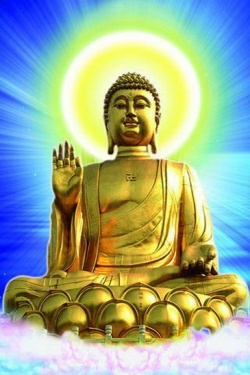Abhidharma/Abhidhamma Literature
The Sanskrit term abhidharma (Pali abhidhamma) probably derives from the expression abhi dharme, “about or relating to the teaching,” indicating the secondary discussion and investigation of the teaching (dharma found in the discourses (Pali sutta, Sanskrit sūtra) of the Buddha. In time, abhidharma became understood as the ultimate expression of that teaching.
Abhidharma literature comprises
(1) the texts that constitute the third of the “three baskets” (tripiṭaka) of the Buddhist canon, and
(2) various exegetical and summary works; the former, like the discourses, were regarded as having the authority of “the word of the Buddha” (buddhavacana).
During the first few centuries of its existence, the Buddhist monastic order (Sangha) divided into a number of schools (nikāya) that developed parallel versions of the canon. While there was relative consensus concerning the content of the first two baskets, comprising the monastic rule (vinaya) and the discourses (sūtra) attributed to the Buddha, the contents and even the status of the third basket were sometimes contentious. How many Buddhist schools preserved a distinctive collection of canonical Abhidharma texts is unclear.
Three versions belonging respectively to the Theravāda, Sarvāstivāda, and (probably) Dharmaguptaka schools survive; canonical Abhidharma collections of the Haimavata, Vātsīputrīya, and Mahāsāṃghika schools are clearly alluded to. The canonical texts are likely to have been composed between the 3rd and 1st centuries BCE. A rich exegetical literature survives both from the Theravāda and Sarvāstivāda traditions, composed mostly in India and Sri Lanka during the 1st millennium CE, though commentaries on Abhidharma texts continued to be composed in the wider Buddhist world of China, Southeast Asia, and Tibet into the 20th century.
Isolated texts belonging to other traditions also survive, while the wider Sarvāstivāda tradition also gave rise to a particular expression of the Abhidharma tradition in the form of the Yogācāra Abhidharma literature.
This article focuses on Abhidharma literature composed in India and Sri Lanka. Abhidharma literature (especially canonical) is often technical, laying out the “grammar” of a system of thought in a manner that assumes familiarity with the language of Abhidharma.
The later manuals and compendia constitute more-accessible guides and overviews but are still technical and difficult works. Abhidharma literature remains relatively underexplored in modern scholarship. Many texts remain untranslated into a modern European language; where there are translations, these are pioneering works often to be used with caution without access to the original text.
General Overviews
There is no book-length study covering the whole of Abhidharma literature. Studies tend to focus either on a particular period or school; Kragh 2002 comes closest to providing a comprehensive overview. The relevant portion of the authoritative Lamotte 1988 places the canonical Abhidharma literature in its broader context. Nakamura 1980 is a generally useful bibliographical resource for Indian Buddhism and in particular gives some indication of the substantial Japanese scholarship. Norman 1983 and Hinüber 1996 provide complementary surveys of the whole of Theravāda Abhidhamma literature within the context of the history of Pali literature generally, while Willemen, et al. 1998 is an indispensable comprehensive guide specifically to Sarvāstivāda Abhidharma literature and its scholarship.
Hinüber, Oskar von. A Handbook of Pāli Literature. Berlin: Walter de Gruyter, 1996.
DOI: 10.1515/9783110814989E-mail Citation »
A text-by-text survey of the Pali literature of the Theravāda school; for Abhidharma texts, see especially pp. 64–75, 149–153, and 160–165.
Kragh, Ulrich T. “The Extant Abhidharma-Literature.” Indian International Journal of Buddhist Studies 3 (2002): 123–167.
E-mail Citation »
A good outline of what survives of the Abhidharma literature of the various schools.
Lamotte, Étienne. History of Indian Buddhism from the Origins to the Śaka Era. Translated by Sara Webb-Boin. Louvain, Belgium: Institut Orientaliste, 1988.
E-mail Citation »
Originally published in French in 1957, this substantial works remains a significant and authoritative guide to the early history of Buddhism in India. For the development of the canonical Abhidharma literature in context, see especially pp. 180–191.
Nakamura, Hajime. Indian Buddhism: A Survey with Bibliographical Notes. Hirakata, Japan: Kansai University of Foreign Studies, 1980.
E-mail Citation »
Particularly useful for providing an indication of the substantial Japanese scholarship on especially Sarvāstivāda Abhidharma; for Abhidharma literature generally, see pp. 104–113.
Norman, K. R. Pāli Literature: Including the Canonical Literature in Prakrit and Sanskrit of All the Hīnayāna Schools of Buddhism. Wiesbaden, Germany: Otto Harrassowitz, 1983.
E-mail Citation »
A general and authoritative account of the history of the Pali literature of the Theravāda school; for Abhidharma literature, see especially pp. 96–107 and 151–153.
Willemen, Charles, Bart Dessein, and Collett Cox. Sarvāstivāda Buddhist Scholasticism. Leiden, The Netherlands; New York: Brill, 1998.
E-mail Citation »
The fullest account of the history of the Abhidharma literature of the Sarvāstivāda school, consisting of four chapters: three by Dessein and a substantial chapter by Cox. Contains many references to the important contributions of Japanese scholars.
Source
http://www.oxfordbibliographies.com/view/document/obo-9780195393521/obo-9780195393521-0252.xml
